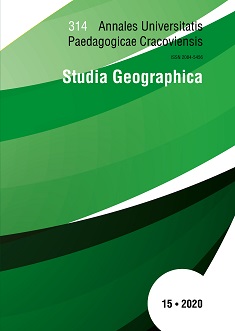Changes in the natural increase and net migration of rural communes of the urban functional areas in Poland in the years of 2002–2017
DOI:
https://doi.org/10.24917/20845456.15.11Keywords:
functional urban areas; natural increase and net migration per 1000 population; rural communes in the suburban areaAbstract
Demographic processes, under stable economy conditions, as a rule are characterized by a low pace. The present size and structure of population of Poland are a consequence of past and present demographic processes (Inter alia changes in vital statistic, migrations, extending of life, fertility), economic processes (inter alia an access to the labor market, services, housing) , as well as of socio-cultural processes (inter alia changes in procreation patterns, the increasing wealth of the society). A distinctive feature of the population changes in Poland is a decreasing number of Polish people. The disadvantageous situation is supported by: progressing population ageing, depopulation in rural areas and a significant number of cities. The adopted aim was to identify the direction of occurring changes in population, vital statistic and migrations of population inhabiting rural communes located in Functional Urban Areas appointed for provincial capitals. The research concerned rural communes belonging to 18 Functional Urban Areas (FUA) of provincial centers, distinguished by Prof P. Śleszyński. The timing analysis covered the time period of 2002-2017. The research applied method of the population development types by J.W.Webb, which enables to identify the links between natural increase and migration rate. The conducted grouping has proved that presently a particularly important factor, which effects the number of habitants of most of the rural communes centered around the core, is the recorded positive migration balance, predominating over positive natural increase. The characteristic feature of the areas under the research is also their considerable internal diversification in respect of analyzed ratios.
References
Bank Danych Lokalnych. GUS. (2019, 2–5 maja). Pozyskano z: https://bdl.stat.gov.pl/
Dane z państwowego rejestru granic i powierzchni jednostek podziałów terytorialnych kraju – PRG, (2018, 14 grudnia). Pozyskano z: ftp://91.223.135.109/prg/jednostki_administracyjne.zip
Długosz, Z. (2001). Próba dynamicznej typologii ruchu ludności w świetle klasyfikacji Webba na przykładzie województwa małopolskiego. W: B. Kortus (red.), Człowiek i przestrzeń. Kraków: IGiGP UJ, 61–70.
Długosz, Z., Kurek, S. (2007). Zmiany w zaludnieniu a ruch naturalny ludności w Polsce w latach 1995–2004. W: J. Lach, M. Borowiec, T. Rachwał (red.), Procesy transformacji społeczno-ekonomicznych i przyrodniczych struktur przestrzennych, Kraków: Wyd. Naukowe Akademii Pedagogicznej w Krakowie, 174–189.
Easterlin, R.A. (1975). An economic framework for fertility analysis. Studies in Family Planning, 6, 3, 54–63.
Easterlin, R.A. (1980). Birth and Fortune: The Impact of Numbers on Personal Welfare. New York: Basic Books.
Eatock, D. (2019). Demographic outlook for the European Union 2019, In-Depth Analysis, European Parliamentary Research Service, Brussels, European Union. Pozyskano z: http://www.europarl.europa.eu/RegData/etudes/IDAN/2019/637955/EPRS_IDA(2019)637955_EN.pdf
Gawryszewski, A. (2007). Zmiany w rozmieszczeniu, ruchu naturalnym, migracjach i strukturze ludności Polski, 1918–2005. Przegląd Geograficzny, 79 (3–4), 461–482.
Kosiński, L. (1964). Typy zmian ludności w Polsce w latach 1951–1960. Przegląd Geograficzny, 36 (4), 661–677.
Kurek, S. (2008). Typologia starzenia się ludności Polski w ujęciu przestrzennym. Prace Monograficzne nr 497, Kraków: Wydawnictwo Naukowe Akademii Pedagogicznej.
Kurek, S., Gałka J., Wójtowicz M. (2015). Powiązania funkcjonalno-przestrzenne w Krakowskim Obszarze Metropolitalnym w świetle dojazdów do pracy. Studia Miejskie, 18, 71–84.
Krzysztofik, R, Szmytkie, R. (2018). Procesy depopulacji w Polsce w świetle zmian bazy ekonomicznej miast. Przegląd Geograficzny, 90 (2), 309–329.
Łuszczyk, M. (2011). Globalizacyjne i demograficzne zagrożenia rozwoju społeczno- -gospodarczego – implikacje dla Polski. W: M. Balcerowicz-Szkutnik (red.), Współczesne problemy demograficzne w dobie globalizacji – aspekty pozytywne i negatywne. Katowice: Wydawnictwo Uniwersytetu Ekonomicznego w Katowicach, 167–173.
Miszczuk, A. (1993). Wyludnianie się wsi a rolnictwo wschodniej Lubelszczyzny. Dokumentacja Geograficzna, 2, 9-86.
Prognoza ludności na lata 2014-2050, (2014). Studia i analizy statystyczne. Warszawa: GUS. Pozyskano z: http://stat.gov.pl/obszary-tematyczne/ludnosc/prognoza-ludnosci/prognoza-ludnosci-na-lata-2014-2050-opracowana-2014-r-,1,5.html
Sytuacja demograficzna Polski (2017). Raport 2016-2017, Rządowa Rada Ludnościowa, Warszawa. Pozyskano z: http://bip.stat.gov.pl/download/gfx/bip/pl/defaultstronaopisowa/805/1/1/sytuacja _demograficzna_polski_raport_2016_2017.pdf
Śleszyński, P., (2013). Delimitacja Miejskich Obszarów Funkcjonalnych stolic województw. Prace Geograficzne, 85 (2), 173–197.
Śleszyński, P., (2016). Współczesne i prognozowane uwarunkowania demograficzno-migracyjne w rozwoju miejskiego systemu osadniczego Polski. Konwersatorium Wiedzy o Mieście, 1 (29), 97–105.
Śleszyński, P., (2018). Demograficzne wyzwania rozwoju regionalnego Polski. Studia KPZK PAN, 183, 225-247.
Śleszyński, P., Wiśniewski R., Szejgiec-Kolenda B., (2018). Demographic processes in Poland in the years 1946‑2016 and their consequences for local development: current state and research perspectives. Geographia Polonica, 91 (3), 317–334.
Uchwała nr 239 Rady Ministrów z dnia 13 grudnia 2011r. w sprawie przyjęcia Koncepcji Przestrzennego Zagospodarowania Kraju 2030 (2012). Monitor Polski, 2012 poz. 252
Ustawa z dnia 27 marca 2003 r. o planowaniu i zagospodarowaniu przestrzennym, (2003). Dziennik Ustaw 2003 nr 80 poz. 717, tekst ujednolicony Dziennik Ustaw 2018 poz. 1945
Van De Kaa, D.J. (1987). Europe’s second demographic transition. Population Bulletin, 42 (1).
Webb, J. W., (1963). The natural and migrational components of population changes in England and Wales 1921–1931. Economic Geography, 39 (2), 130–148.
Wesołowska, M., (2016). Depopulacja wsi – szansa czy zagrożenie dla przestrzeni wiejskiej. Studia KPZK PAN, 167, 250–273.
Downloads
Published
Issue
Section
License
The submission of a paper to be published is synonymous with an agreement to transfer the copyright free of charge from the author to the publisher. The author also agrees to permit the publisher to publish the paper in printed form, open access online form, digital library form and other digital platforms with which the publisher has or will have a publishing agreement. Furthermore, the author agrees to not limit the number of copies that may be printed or issued by the publisher. In the case of co-authored papers, it is assumed that the corresponding author is authorized to represent the remaining co-authors in this respect. Authors are requested to sign a copyright declaration.

